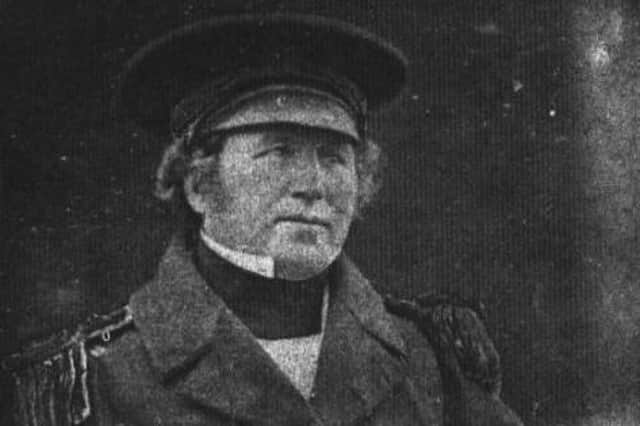Francis Rawdon Moira Crozier, NI polar explorer whose death in 1800s remains a mystery


Francis Rawdon Moira Crozier was born on October 17 1796 at Avonmore House, Church Square, in Banbridge. He was one of the 13 children of George Crozier, a solicitor whose most important clients were the Marquess of Downshire and the Earl of Moira, and his wife Jane Elliot Crozier (née Graham). Both his father and mother’s families were of Ulster-Scots and Border Reiver descent. Francis Crozier was named after Francis Rawdon, the 2nd Earl of Moira.
Originally the Crozier family was Presbyterian but, like many upwardly mobile Presbyterians, they abandoned Presbyterianism for the Church of Ireland.
Advertisement
Hide AdAdvertisement
Hide AdCrozier attended school locally in Banbridge, with his brothers William and Thomas, and joined the navy at the age of 13. From an early stage he became involved in polar exploration and his career later became entwined with that of Sir John Franklin.
Crozier fell in love with Sophia Cracroft, Franklin’s niece who toyed with his affections, dismissed him as ‘a radical and an indifferent speller’ and left him profoundly unhappy. James Clark Ross, Crozier’s friend and fellow naval officer, was apparently the true object of her affections.
In December 1835 Crozier joined an expedition to Davis Strait and Baffin Bay in the Arctic, to search for missing British whalers. He travelled with Captain James Ross to the Antarctic (1839-43) and was promoted to captain in his absence in 1841. During these expeditions Crozier experimented in magnetic observation, and by the 1840s was recognised as an expert in this field. In March 1845 Crozier joined Sir John Franklin on an expedition to the Arctic in search of a Northwest Passage – at this point essentially a hypothetical sea route around the top of North America to Asia.
Sir John Franklin commanded the Erebus, while Crozier was appointed captain of the Terror, the second ship.
Advertisement
Hide AdAdvertisement
Hide AdBoth ships were equipped with iron-layered hulls and auxiliary steam engines designed to withstand the intense Arctic ice. Both were also stocked with three years’ worth of food including 32,000 pounds of preserved meat, 1,000 pounds of raisins, and 580 gallons of pickles.
The ships were last seen by a British whaler in July 1845, at the head of Baffin Bay, after which they were not seen again.
The loss of the expedition was one of the great mysteries of the 19th century, and up to a point some aspects of it still are. Over the next 30 years, 26 search operations (seven of them sponsored by the formidable Lady Franklin) were carried out, but the two ships were not discovered until Canadian government sponsored diving expeditions by Parks Canada found the Erebus in 2014 and the Terror in 2016. The exploration of the wrecks was interrupted by Covid.
However, in May 1859 the Fox expedition under the Dundalk-born Captain Leopold McClintock discovered a document under a cairn of stones at Cape Herschel on King William Island.
Advertisement
Hide AdAdvertisement
Hide AdIt explained how the ships had initially fared well until beset by ice in September 1846 off the west coast of King William Island.
When Franklin died in June 1847, Crozier assumed command.
As rations ran short and the crew took ill, he decided to abandon the ships in April 1848, and headed south in search of help.
The 105 men remaining began their journey on April 26 and died sometime thereafter. The men would have set off in a weakened condition and wearing only inadequate cloth garments. The expedition was not provided with skins and furs. Their boots would have worn out on the rough ice.
McClintock's party found the remains of campsites, equipment, and the bodies of crew members.
Advertisement
Hide AdAdvertisement
Hide AdModern forensic tests on the bodies noted signs of vitamin C deficiency and lead poisoning, thought to be caused by the poor quality of the tinned rations. Faulty soldering may have resulted in much of the tinned food rotting.
The Inuit claim that Crozier was among the last members of the expedition to perish, or even the very last (hence the title of Michael Smith’s biography ‘Last Man Standing’) but unfortunately there is no hard evidence for this. Inuit oral tradition suggests that an officer fitting Crozier’s description was seen much further east in the 1850s. American search expeditions of the 1860s brought back tales of a survivor, who was so skilled at hunting that he shared his food with local Inuit.
In addition to the full-length statue in Church Square in Banbridge, there is a memorial plaque recording Crozier’s fate in Seapatrick parish church. The extraordinarily beautiful Georgian house in which Crozier was born, Barre’s memorial and the church are all near each other.
In 2018 Michael Palin, following in the footsteps of Charles Dickens, Jules Verne, Willkie Collins and Mark Twain, added to the already huge literature on the Franklin expedition – an incredible 3,000 books according to Google – by publishing ‘Erebus: The Story of a Ship’.
Advertisement
Hide AdAdvertisement
Hide AdThe North American edition is helpfully entitled for its readership ‘Erebus, One Ship, Two Epic Voyages, and The Greatest Naval Mystery of All Time’.
Crozier, who never received the recognition that was his due in his lifetime, is one of Palin’s favourite characters in the story of the Franklin expedition. In October 2018 he visited Banbridge to pay his respects to this remarkable Ulster Scot.
And what of the Northwest Passage? Well, it exists and spans roughly 900 miles from the North Atlantic north of Canada’s Baffin Island in the east to the Beaufort Sea north of Alaska in the west.
The Norwegian explorer Roald Amundsen became the first to successfully navigate the Northwest Passage in 1906. Climate change has caused Arctic ice cover to thin, opening the passage to marine shipping. In summer 2007, the route was entirely ice-free for the first time in recorded history.